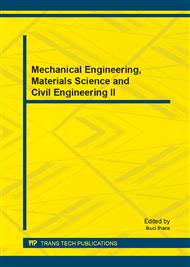[1]
F.Y. Han. The research on novel forward kinematics numerical algorithm and workspace ontology for parallel robot [D]. 2011, Jilin University.
Google Scholar
[2]
X.L. Ma, A.H. Chen, X.L. Zhang, et al. Progress in the innovation and application of parallel robot mechanism [J]. Machine Tool & Hydraulics, 2007, 35(2): 235-237+243.
Google Scholar
[3]
H. Zhang, Q.M. Wang, P. Ye, et al. Forward kinematics of general Stewart platform and the application [J]. Chinese Journal of Mechanical Engineering, 2002, 38(S1): 108-112.
DOI: 10.3901/jme.2002.supp.108
Google Scholar
[4]
P. Nanua, K.J. Waldron, V. Murthy. Direct kinematic solution of a Stewart platform [J]. IEEE Transactions on Robotics and Automation, 1990, 6(4): 438-444.
DOI: 10.1109/70.59354
Google Scholar
[5]
K.H. Hunt, E.J.F. Primrose. Assembly configurations of some parallel-actuated manipulators [J]. Mech. Mach. Theory, 1993, 28(1): 31-42.
DOI: 10.1016/0094-114x(93)90044-v
Google Scholar
[6]
B. Dasgupta, T.S. Mruthyunjaya. Canonical formulation of the direct position kinematics problem for a general 6-6 Stewart platform [J]. Mech. Mach. Theory, 1994, 29(6): 819-827.
DOI: 10.1016/0094-114x(94)90081-7
Google Scholar
[7]
S.V. Sreenivasan, P. Nanua. Solution of the direct position kinematic problem of the general Stewart platform using advanced polynomial continuation[C]. The 22nd Biennial Mechanisms conference, 1992, Scottsdale , New York, ASME, 1992: 99-106.
DOI: 10.1115/detc1992-0203
Google Scholar
[8]
X.G. Huang, Q.Z. Liao, S.M. Wei. Forward displacement analysis of Stewart platform robot [J]. Electric Machines and Control, 2009, 13(S1): 105-108.
Google Scholar
[9]
S. Liu, W.L. Li, Y.C. Du, et al. Forward kinematics of the Stewart platform using genetic neural algorithm [J]. Journal of Harbin Engineering University, 2006. 27(z1): 79-82.
Google Scholar
[10]
D. Zhang, Z. Gao. Forward kinematics performance analysis and multi-objective optimization of a bio-inspired parallel manipulator [J]. Robotics and Computer-Integrated Manufacturing, 2012, 28(4): 484-492.
DOI: 10.1016/j.rcim.2012.01.003
Google Scholar
[11]
Y.X. Wang, Y.M. Wang, L. Yang, et al. Direct displacement and configurations analyses of symmetrical Stewart platform mechanisms [J]. China Mechanical Engineering, 2002, 13(09): 734-737.
Google Scholar
[12]
C.H. Liu, K. Huang and Y. Wang. Forward position analysis of 6-3 Linapod parallel manipulators [J]. Springer. Meccanica, 2012, 47(5): 1271-1282.
DOI: 10.1007/s11012-011-9511-4
Google Scholar
[13]
C.Q. Wang, H.T. Wu. Kinematics Analysis of 6-PUS Parallel Mechanism [J]. China Mechanical Engineering, 2013, 24(07): 853-856.
Google Scholar
[14]
X.M. Shi, Z.Q. Hao, Fuzzy control and MATLAB simulation [M]. Beijing: Beijing Jiaotong University Press, (2008).
Google Scholar
[15]
P.K. Jamwal, et al. Forward kinematics modelling of a parallel ankle rehabilitation robot using modified fuzzy inference [J]. Mechanism and Machine Theory, 2010, 45(11): 1537-1554.
DOI: 10.1016/j.mechmachtheory.2010.06.017
Google Scholar


